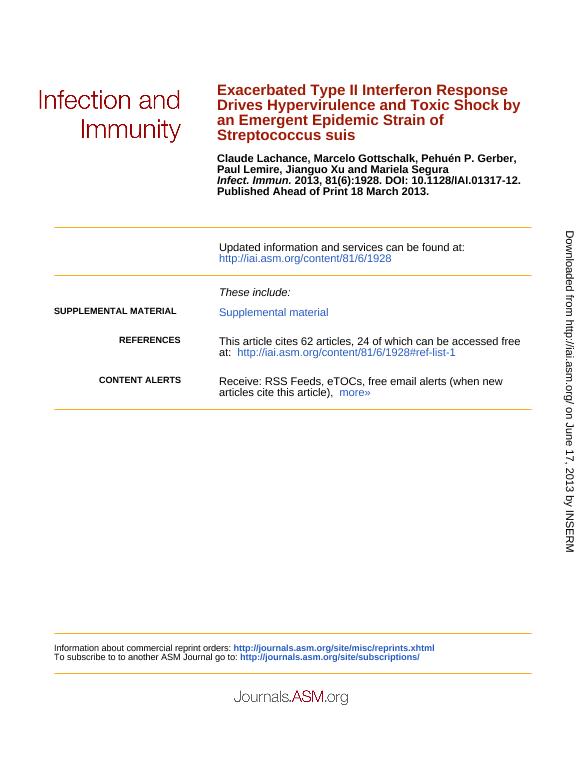Mostrar el registro sencillo del ítem
dc.contributor.author
Lachance, Claude
dc.contributor.author
Gottschalk, Marcelo
dc.contributor.author
Pereyra Gerber, Federico Pehuén

dc.contributor.author
Lemire, Paul
dc.contributor.author
Xu, Jianguo
dc.contributor.author
Segura, Mariela
dc.date.available
2016-11-24T17:49:26Z
dc.date.issued
2013-06
dc.identifier.citation
Lachance, Claude; Gottschalk, Marcelo; Pereyra Gerber, Federico Pehuén; Lemire, Paul; Xu, Jianguo; et al.; Exacerbated Type II Interferon Response Drives Hypervirulence and Toxic Shock by an Emergent Epidemic Strain of Streptococcus suis; American Society For Microbiology; Infection And Immunity; 81; 6; 6-2013; 1928-1939
dc.identifier.issn
0019-9567
dc.identifier.uri
http://hdl.handle.net/11336/8356
dc.description.abstract
Streptococcus suis, a major porcine pathogen, can be transmitted to humans and cause severe symptoms. A large human outbreak associated with an unusual streptococcal toxic shock-like syndrome (STSLS) was described in China. Albeit an early burst of proinflammatory cytokines following Chinese S. suis infection was suggested to be responsible for STSLS case severity, the mechanisms involved are still poorly understood. Using a mouse model, the host response to S. suis infection with a North American intermediately pathogenic strain, a European highly pathogenic strain, and the Chinese epidemic strain was investigated by a whole-genome microarray approach. Proinflammatory genes were expressed at higher levels in mice infected with the Chinese strain than those infected with the European strain. The Chinese strain induced a fast and strong gamma interferon (IFN-γ) response by natural killer (NK) cells. In fact, IFN-γ-knockout mice infected with the Chinese strain showed significantly better survival than wild-type mice. Conversely, infection with the less virulent North American strain resulted in an IFN-β-subjugated, low inflammatory response that might be beneficial for the host to clear the infection. Overall, our data suggest that a highly virulent epidemic strain has evolved to massively activate IFN-γ production, mainly by NK cells, leading to a rapid and lethal STSLS.
dc.format
application/pdf
dc.language.iso
eng
dc.publisher
American Society For Microbiology

dc.rights
info:eu-repo/semantics/openAccess
dc.rights.uri
https://creativecommons.org/licenses/by-nc-sa/2.5/ar/
dc.subject
Streptococcus Suis
dc.subject
Interferon Gamma
dc.subject
Toxic Shock
dc.subject
Host Response to Pathogens
dc.subject.classification
Inmunología

dc.subject.classification
Medicina Básica

dc.subject.classification
CIENCIAS MÉDICAS Y DE LA SALUD

dc.title
Exacerbated Type II Interferon Response Drives Hypervirulence and Toxic Shock by an Emergent Epidemic Strain of Streptococcus suis
dc.type
info:eu-repo/semantics/article
dc.type
info:ar-repo/semantics/artículo
dc.type
info:eu-repo/semantics/publishedVersion
dc.date.updated
2016-11-24T17:19:58Z
dc.journal.volume
81
dc.journal.number
6
dc.journal.pagination
1928-1939
dc.journal.pais
Estados Unidos

dc.journal.ciudad
Washington
dc.description.fil
Fil: Lachance, Claude. University Of Montreal; Canadá
dc.description.fil
Fil: Gottschalk, Marcelo. University Of Montreal; Canadá
dc.description.fil
Fil: Pereyra Gerber, Federico Pehuén. University Of Montreal; Canadá. Consejo Nacional de Investigaciones Científicas y Técnicas. Oficina de Coordinación Administrativa Houssay; Argentina
dc.description.fil
Fil: Lemire, Paul. University Of Montreal; Canadá
dc.description.fil
Fil: Xu, Jianguo. Chinese Center For Disease Control And Prevention; China
dc.description.fil
Fil: Segura, Mariela. University Of Montreal; Canadá
dc.journal.title
Infection And Immunity

dc.relation.alternativeid
info:eu-repo/semantics/altIdentifier/url/http://iai.asm.org/cgi/pmidlookup?view=long&pmid=23509145
dc.relation.alternativeid
info:eu-repo/semantics/altIdentifier/url/https://www.ncbi.nlm.nih.gov/pmc/articles/PMC3676015/
dc.relation.alternativeid
info:eu-repo/semantics/altIdentifier/doi/https://dx.doi.org/10.1128/IAI.01317-12
Archivos asociados
